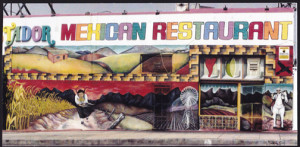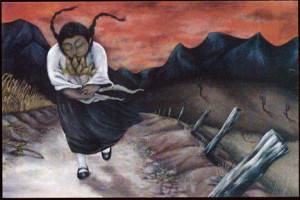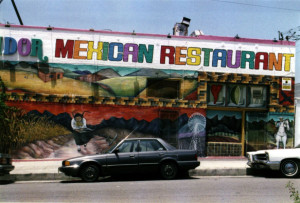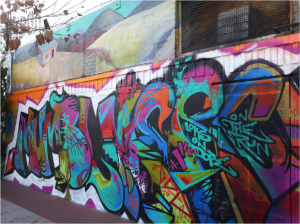The second mural I visited, called Y Maria Va, is painted on El Conquistador Mexican Restaurant in Silverlake by Leonardo Giacomuzzo and Christian Anson. This mural has many connections with the gothic genre and the Chicano movement. My purpose in part 2 of the project is to demonstrate how the Chicano themes of this particular mural correlate with the gothic elements discussed throughout the course including certain texts. For instance, a student of CHST332 should recognize that the imagery of the mural contain immediate themes to our reading of Bless Me, Ultima.
The mural’s various panels prompt similarities to elements of Bless Me, Ultima. For starters, the main image in the center of the mural, shares imagery that is found in the book. The barren landscape, dark mountains, and red sky are parts that together evoke gothic and Chicano elements. The setting of the book, a New Mexican landscape during the period of World War II and home to Ultima and Antonio, depicts a world with rolling hills and dry, parched earth. The main figure, a young girl, can represent Antonio, both seeming to run away from their past in distress. The innocence and gentleness the girl displays bring correlations with scenes of Antonio scampering back to his home late at night, head down and wanting to forget what he had just witnessed, the murders of Lupito and Narcisso.
Furthermore, the top panel displays an almost seemingly identical representation of Antonio’s home. The isolated residence of the Marez/Luna family in the rolling, barren hills of New Mexico suggests correlations to the gothic and the Chicano.
Additionally, the far top right panel of the mural contains an interesting image that lends a hand to the connection of the gothic and the Chicano. An image of a raven can be seen flying away from the mural off into the blood, red sky. The representation of a raven, with its most famous example stemming from a very gothic author, Edgar Allen Poe, and along with the element of the red sky add to the overall gothic-ness of the mural.
With the rise of Chicano murals in Los Angeles in the 80s and 90s, graffiti soon followed. Graffiti, interestingly enough, has numerous gothic elements, and this mural, in particular, has this additional gothic-ness. Unfortunately, Y Maria Va has a large amount of graffiti that the original artists never intended to add to the message of the mural. Having researched the mural before visiting it, I was excited to analyze the main panel in great detail, but as I approached the image, I felt much sadness and devastation. As seen in the photo, graffiti covers the entire main panel that shows the girl running through the barren, and very gothic landscape. The inability to view this section of the mural in person leaves me to wonder the reasons behind defacing such a piece of art. Taggers, all through Los Angeles, have forced themselves to be integrated in the history, message, and cultural significance of the murals that they chose to vandalize. As I voiced in Part 1, Los Angeles needs to be more effective in its preservation of its murals, which serves as a vital instrument in its orchestra of cultural history.
Works Cited: Giacoumuzzo, Leonardo, and Christian Anson. “Y Maria Va, El Conquistador Restaurant.” Public Art in LA,Web. 20 Apr. 2014.
Photos: http://www.publicartinla.com/LA_murals/Silverlake/conquistador.html





I agree that that the colors and imagery exemplify both Chicano/a and gothic imagery. As you pointed out, the color scheme (red and black), the features of the land (barren, rocky, isolated) and especially the crow are tropes of Gothic images. The representation of the corn is significant, too. It is symbolic in Aztec and Mayan life: people are dependent on it. As a grain, it is versatile, it’s in a lot of our food and its stalks can be made into baskets and tamales. That it would be featured on a restaurant mural is not too surprising. There is something melancholy about the girl in the mural-she’s hunkered down in either sadness or (more likely) braving the elements during a strong windstorm.
I agree that it is a shame that murals are not protected and celebrated more by our city and by taggers. They represent something important about our city’s past and its inhabitants’ past in Mexico and central America.
I look at this mural and I cannot help but think about the celebrated Mexican muralist from the early to middle 20th century. The endurance of the native-looking woman resembles the campesinos depicted in Rivera’s paintings. It is nice to see this emphasis on aboriginal people, it shows that despite migration, the pride this heritage inspires still survives. The aridness of the landscape, with its almost cruel aloofness, reminds me of Orozco’s work. The black and reddish environment is particularly reminiscent of Orozco’s palette in his murals and paintings. Moreover, this artist also dedicated a lot of this work to glorify the peasantry and their importance as the basis for a harmonious society. The character of this woman is emphasize by the desolation of the place where she is walking, carrying a small but important sustenance.
I completely agree with your comparison to the character in “Bless me, Ultima” . I am glad you decided to analyze the public art of Los Angeles since it plays such an important part on establishing the chicano character of our city.
Here’s an example of the paintings and murals this particular piece reminded me of:
http://www.most-famous-paintings.org/141066/Peasants–1947-large.jpg
http://uploads8.wikipaintings.org/images/jose-clemente-orozco/omnisciencia-1925.jpg
It’s unfortunate that this mural was vandalized, however, it is also very interesting. Graffiti is a main trope of LA and representative of gang life. It is one way for these gangs to express themselves and let others know that they are there I think that being in a gang in LA definitely makes people view you in a negative way. Because of this, these people are not given a voice in the same way that other people have a voice. This is one of the few ways that they can voice their opinions and get people to listen. Unfortunately they covered up someone else’s message by doing so.
I really enjoyed your project and presentation. I am an admirer of Los Angeles’ public art/murals and I love spotting them while around the city. Huffington Post recently published a list of twenty-six cities (http://www.huffingtonpost.com/2014/04/17/best-street-art-cities_n_5155653.html) with the most impressive public art and Los Angeles, and a few Latin American cities, including Mexico City, were on the list. In Mexico, public art became a large artistic political/social movement post-Revolution when the government wanted to unite the country under one mestizo identity and through the nation’s history. Rivera, Orozco, Siquieros, and were “the great muralists” of this era. It appears that the tradition of murals/public art still exists within the Chican@/Mexican/Latin@ communities in Los Angeles. As you noted and observed, they appear on stores and restaurants. They are even on homes, schools, and churches at times. Public art is an amazing way to share one’s history, values, concerns, and personal narratives. And it is just that–public, for everyone to enjoy. With the contributions of Mexican/Chican@/Latin@ artists in Los Angeles, it is also a way to preserve one’s culture. As you mentioned, it would be ideal for public art to be preserved. Hopefully that it addressed in the future, and if not, then hopefully artists continue with this tradition, leaving their legacy on the walls of the City of Angels.